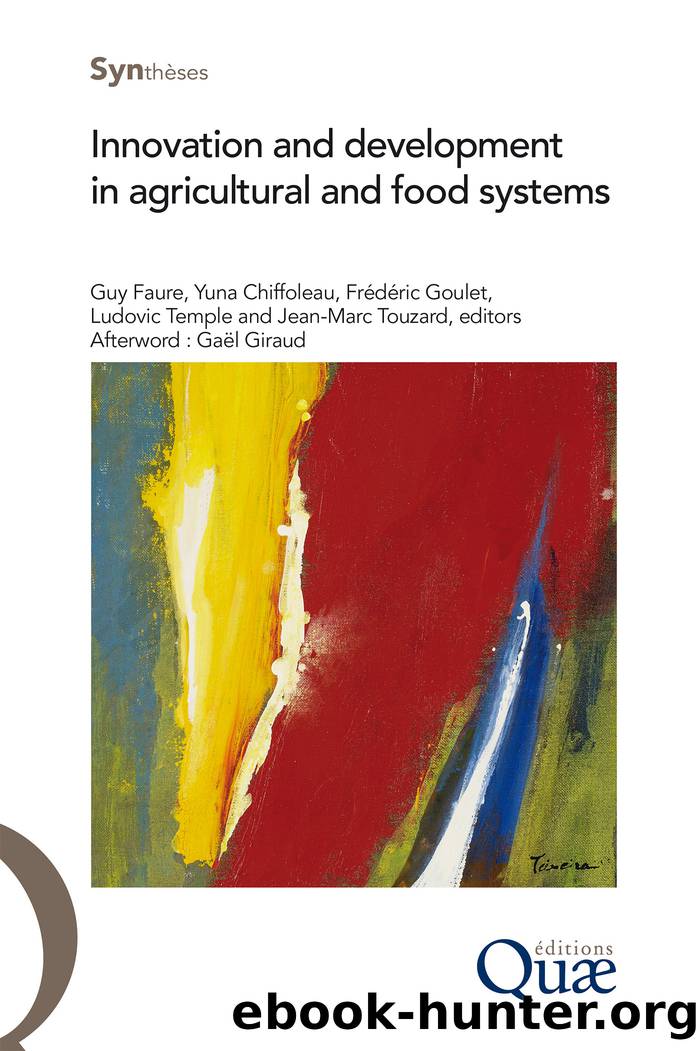Innovation and development in agricultural and food systems by Guy Faure Yuna Chiffoleau Frédéric Goulet Ludovic Temple Jean-Marc Touzard

Author:Guy Faure, Yuna Chiffoleau, Frédéric Goulet, Ludovic Temple, Jean-Marc Touzard
Language: fra
Format: epub
Publisher: éditions Quæ
Published: 2018-11-16T00:00:00+00:00
Managing innovation strategically: the contributions of theories of learning and of management
Research on strategic management and learning is increasingly being used to reinforce the field of analysis of action in order to support the emergence and rise of innovation communities (TAP, 2016), and thus moderate the overly analytical knowledge generated by approaches centred on innovation systems.
The aim is to focus on actors in innovation situations and on their support needs, by recognizing that in the field of agricultural development, the actors are neither experienced nor trained in the collective design of innovation, nor are they used to working together towards a common goal. We define an innovation situation on the basis of the definition by Girin (2016) of the management situation. It involves, on the one hand, a community of actors undertaking activities, more or less coordinated, which contribute to developing the innovation and, on the other, physical, cognitive and relational resources that can be used to innovate. Each of these actors has a specific interest in the innovation being developed and their cooperation is guided by common goals. The complexity of an innovation situation can vary depending on the changes required at the individual and collective levels (changes in knowledge, attitudes, practices, rules) and the degree of uncertainty encountered.
As advocated by learning theories, developing individualsâ innovation capacities must be the core of the accompaniment approaches being tried out. The capacity to innovate refers to the knowledge and skills a group needs to effectively use, master and improve existing resources, or create new ones, in order to innovate (Hall, 2005). It includes the ability to apprehend the situation and its environment, set goals, take risks, experiment and implement concerted actions, build relationships and alliances, and mobilize resources. It is a matter of both technical and functional capabilities (TAP, 2016).
The managerial perspective helps to establish principles of action and to create useful tools for accompaniement practitioners. By relying on the theories of adult learning (Kolb et al., 2001), it becomes possible to determine which tools to use, given the types of learning that must be generated, whether they are simple or transformative, involving changes in knowledge, attitudes, practices, rules of action or values. The tools can be diverse and may consist of, for example, a dashboard, a computer model, a field visit, a participatory workshop, a monitoring committee, or a charter. They promote learning by guiding reflection, participating in the creation of a common language, or orienting action. Each tool must be seen as part of an intervention method that makes sense of the use of the tool.
Research about innovation management draws attention to the complexity of innovation situations, i.e. to the multiplicity of the critical drivers of innovation at different levels, individual, organizational and inter-organizational (or collective), so that action can be taken on them (Crossan and Apaydin, 2010). For example, we can compare two innovation situations: the adaptation of an agricultural technique to a particular agroecological context vs the creation of a new agricultural model based on agroecological principles (Figure 8.
Download
This site does not store any files on its server. We only index and link to content provided by other sites. Please contact the content providers to delete copyright contents if any and email us, we'll remove relevant links or contents immediately.
Craft Beer for the Homebrewer by Michael Agnew(17463)
Marijuana Grower's Handbook by Ed Rosenthal(3126)
Barkskins by Annie Proulx(2886)
Project Animal Farm: An Accidental Journey into the Secret World of Farming and the Truth About Our Food by Sonia Faruqi(2668)
Red Famine: Stalin's War on Ukraine by Anne Applebaum(2471)
The Plant Messiah by Carlos Magdalena(2458)
Organic Mushroom Farming and Mycoremediation by Tradd Cotter(2314)
0041152001443424520 .pdf by Unknown(2229)
In the Woods by Tana French(2009)
Beer is proof God loves us by Charles W. Bamforth(1936)
The Art of Making Gelato by Morgan Morano(1902)
Meathooked by Marta Zaraska(1896)
Birds, Beasts and Relatives by Gerald Durrell(1871)
Reservoir 13 by Jon McGregor(1859)
The 7 Habits of Highly Effective People: Powerful Lessons in Personal Change (25th Anniversary Edition) by Covey Stephen R(1841)
Borders by unknow(1792)
The Lean Farm Guide to Growing Vegetables: More In-Depth Lean Techniques for Efficient Organic Production by Ben Hartman(1790)
The 7 Habits of Highly Effective People: Powerful Lessons in Personal Change by Stephen R. Covey(1768)
Urban Farming by Thomas Fox(1753)
